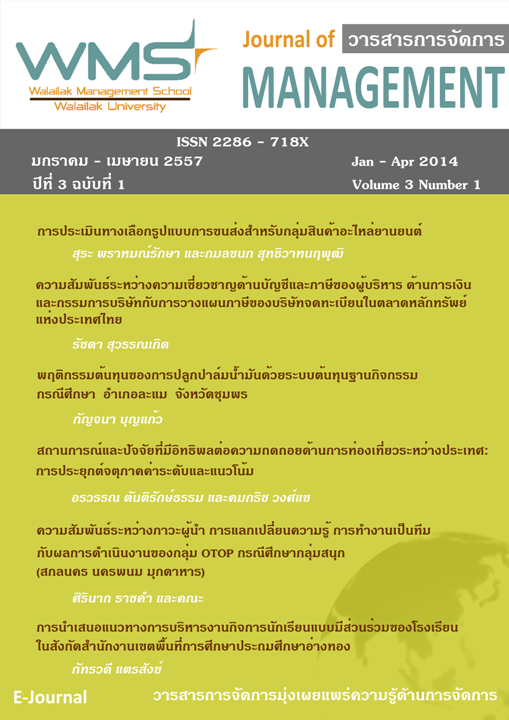Evaluation of Transportation Alternatives for Automotive Products
Main Article Content
Abstract
Article Details
References
ครองขวัญ ชินรุ่งโรจน์. 2549. ปัจจัยที่มีผลต่อการตัดสินใจขนส่งตู้สินค้าด้วยเรือลำเลียง. วิทยานิพนธ์ปริญญามหาบัณฑิต. สาขาวิชาการจัดการด้านโลจิสติกส์บัณฑิตวิทยาลัย จุฬาลงกรณ์มหาวิทยาลัย.
เครือวัลย์ จำปาเงิน. 2547. การพัฒนาระบบสนับสนุนการ ตัดสินใจเพื่อจัดเส้นทางเดินรถสำหรับการขนส่ง สินค้าเพื่อการบริโภคสู่ร้านค้าปลีกในสถานบริการ น้ำมันในจังหวัดนนทบุรี. วิทยานิพนธ์ปริญญา มหาบัณฑิต. ภาควิชาภูมิศาสตร์ คณะอักษรศาสตร์ จุฬาลงกรณ์มหาวิทยาลัย.
จักรพล เครือวัลย์. 2553. การพิจารณาเลือกแหล่งซ่อมที่ เหมาะสมสำหรับอากาศยานแบบลำเลียงของ กองทัพอากาศ. โครงงานพิเศษตามหลักสูตรปริญญา มหาบัณฑิต. สาขาวิชาการจัดการด้านโลจิสติกส์ บัณฑิตวิทยาลัย จุฬาลงกรณ์มหาวิทยาลัย.
จุฑาฑิพย์ เจริญประเสริฐกุล. 2554. นโยบายการส่งสินค้า สำหรับการขนส่งสองรูปแบบ. วิทยานิพนธ์ปริญญา มหาบัณฑิต. สาขาวิชาการจัดการด้านโลจิสติกส์ บัณฑิตวิทยาลัย จุฬาลงกรณ์มหาวิทยาลัย.
เจริญ วาริพันธน์. 2550. ปัจจัยทางการตลาดที่มีผลต่อการขนส่งสินค้าเกษตรด้วยระบบตู้คอนเทนเนอร์. วิทยานิพนธ์ปริญญามหาบัณฑิต. สาขาวิชาการจัดการ ด้านโลจิสติกส์ บัณฑิตวิทยาลัย จุฬาลงกรณ์มหาวิทยาลัย.
จิรวัฒน์ เอมโกษา. 2544. การประยุกต์ใช้กระบวนการลำดับชั้น เชิงวิเคราะห์สำหรับการตัดสินใจเลือกผู้ผลิตชิ้นส่วน กรณีศึกษาโรงงานประกอบรถยนต์. วิทยานิพนธ์ ปริญญามหาบัณฑิต. ภาควิชาวิศวกรรมอุตสาหการ คณะวิศวกรรมศาสตร์ มหาวิทยาลัยธรรมศาสตร์.
ชาลิศา ตั้งตระกูล. 2551. การศึกษาต้นทุนการบริหารการกระจายสินค้าเครื่องดื่มน้ำอัดลม. วิทยานิพนธ์ปริญญามหาบัณฑิต. สาขาวิชาการจัดการด้านโลจิสติกส์ บัณฑิตวิทยาลัยจุฬาลงกรณ์มหาวิทยาลัย.
ณัติฐากร ชูก้าน และอรรถกร เก่งพล. 2547. การออกแบบระบบ สนับสนุนการตัดสินใจในการประเมินบริษัท ขนส่งโดยใช้ตัวแบบขนส่ง Multi commodity, AHP และ.PL วารสารวิชาการพระจอมเกล้าพระนครเหนือ 2547: 49-58.
ธงชัย เจริญสวัสดิ์. 2549. ปัญหาการขนส่งสินค้าระบบตู้คอนเทน เนอร์ด้วยรถไฟ เส้นทางสถานีบรรจุและแยกสินค้า กล่อง ลาดกระบัง – ท่าเรือแหลมฉบัง. วิทยานิพนธ์ ปริญญามหาบัณฑิต. สาขาวิชาการจัดการด้านโลจิสติกส์ บัณฑิตวิทยาลัย จุฬาลงกรณ์มหาวิทยาลัย.
นฤภร กาญจนรัตน์. 2542. ระบบการจัดเส้นทางการขนส่ง: กรณีศึกษาการขนส่งเฟอร์นิเจอร์ประเภทถอด ประกอบ. วิทยานิพนธ์ปริญญามหาบัณฑิต. ภาควิชา วิศวกรรมอุตสาหการ คณะวิศวกรรมศาสตร์ จุฬาลงกรณ์มหาวิทยาลัย.
ปิติ ปิติเพิ่มพูน. 2550. กระบวนการลำดับชั้นเชิงวิเคราะห์สำหรับการตัดสินใจมีรถขนส่งของตนเอง. วิทยานิพนธ์ปริญญามหาบัณฑิต. สาขาวิชาการจัดการด้านโลจิสติกส์ บัณฑิตวิทยาลัยจุฬาลงกรณ์มหาวิทยาลัย.
ประพล เสถียรภาพงษ์. 2548. ศักยภาพในการเปลี่ยนการขนส่ง สินค้าภายในประเทศไทยจากการขนส่งด้วย รถบรรทุก เป็นการขนส่งโดยเครื่องบิน. วิทยานิพนธ์ปริญญามหาบัณฑิต. สาขาวิชาการจัดการด้านโลจิสติกส์ บัณฑิตวิทยาลัย จุฬาลงกรณ์มหาวิทยาลัย.
พรทิพย์ ตั้งจิตเจริญพาณิช. 2548. ทำการศึกษาเปรียบเทียบ รูปแบบการกระจายสินค้าอุปโภคบริโภคระหว่างการ ขนส่งผ่านศูนย์กระจายสินค้ากับการขนส่งโดยตรง. วิทยานิพนธ์ปริญญามหาบัณฑิต. สาขาวิชา การจัดการด้านโลจิสติกส์ บัณฑิตวิทยาลัยจุฬาลงกรณ์มหาวิทยาลัย.
แลมเบิร์ท, ดี. เอ็ม., สต็อก, เจ. อา., เอลแรม, แอล. เอ็ม. 2547. การจัดการโลจิสติกส์. แปลและเรียบเรียงโดย กมลชนก สุทธิวาทนฤพุฒิ, ศลิษา ภมรสถิตย์ และ จักรกฤษณ์ ดวงพัสตรา. กรุงเทพมหานคร: สำนักพิมพ์แมคกรอ-ฮิล.
วิทูรย์ ตันศิริคงคล. 2542. AHP กระบวนการตัดสินใจที่ได้รับ ความนิยมมากที่สุดในโลก. กรุงเทพมหานคร: กราฟฟิค แอนด์ ปรินติ้ง เซ็นเตอร์.
วิษารัช สัญญาลักษณ์ฤาชัย. 2549. โครงการศึกษาปัจจัยที่มีผล ต่อการตัดสินใจเลือกผู้ประกอบการขนส่งในสาขา อุตสาหกรรมประกอบรถยนต์. กรุงเทพมหานคร: จุฬาลงกรณ์มหาวิทยาลัย.
เศกสรรค์ ตั้นตระกูล. 2550. การประยุกต์ใช้เทคนิค AHP ในการประเมินทางเลือกสำหรับการขนส่งผลิตภัณฑ์เหล็ก. วิทยานิพนธ์ปริญญามหาบัณฑิต. สาขาวิชาการจัดการด้านโลจิสติกส์ บัณฑิตวิทยาลัย จุฬาลงกรณ์มหาวิทยาลัย.
สมัญญา รังสิเสนา ณ อยุธยา. 2552. ปัจจัยสำหรับการบริหารฝูงรถยนต์เสื่อมสภาพของกองทัพอากาศโดยกระบวนการลำดับชั้นเชิงวิเคราะห์. วิทยานิพนธ์ ปริญญามหาบัณฑิต. สาขาวิชาการจัดการด้านโลจิสติกส์ บัณฑิตวิทยาลัย จุฬาลงกรณ์มหาวิทยาลัย.
สิรินทรา เงินเย็น. 2553. การปรับปรุงประสิทธิภาพของการจัดส่งชิ้นส่วนยานยนต์แบบมิลค์รันสำหรับโรงงานประกอบรถยนต์. วิทยานิพนธ์ปริญญามหาบัณฑิต. ภาควิชาวิศวกรรมอุตสาหการ คณะวิศวกรรมศาสตร์ จุฬาลงกรณ์มหาวิทยาลัย.
อดิศักดิ์ นันทวิศาล. 2551. การประยุกต์ใช้กระบวนการลำดับชั้น เชิงวิเคราะห์ในการเตรียมการจัดหาอากาศยาน กองทัพอากาศ. วิทยานิพนธ์ปริญญามหาบัณฑิต. สาขาวิชาการจัดการด้านโลจิสติกส์ บัณฑิตวิทยาลัย จุฬาลงกรณ์มหาวิทยาลัย.
Awasthi, A., Chauhan, S. S. 2011. Using AHP and DempstereShafer theory for evaluating sustainable transport solutions. Environmental Modelling & Software 26: 787-796.
Crevier, B., Cordeau, J. F., Savard, G. 2012. Integrated operations planning and revenue management for rail freight transportation. Transportation Research Part B 46: 100-119.
Forkenbrock, D. J. 2001. Comparison of external costs of rail and truck freight transportation. Transportation Research Part A 35: 321-337.
Lambert, M. D., Stock, R. J., and Ellram, L. M. 1998. Fundamentals of Logistics Management. Massachusetts: McGraw-Hill.
Matsika, E., Ricci, S., Mortimer, P., Georgiev, N., O’Neill, C. 2013. Rail vehicles, environment, safety and security. Research in Transportation Economics 41: 43-58.
Nealer, R., Weber, C. L., Hendrickson, C., Matthews, H. S. 2011. Modal freight transport required for production of US goods and services. Transportation Research Part E 47: 474-489.
Nozick, L. K., Morlok, E. K. 1997. A model for medium-term operations planning in an intermodal rail-truck service. Transportation Research Part A 31: 91- 107.
Polak, G., Koshal, R. K. 1980. Production function and changing technology for water transport - Some empirical results. Transportation Research Part A 14A: 279-284.
Reis, V., Meier, J. F., Pace, G., Palacin, R. 2013. Rail and multi-modal transport. Research in Transportation Economics 41: 17-30.
Rodrigue, J. P. 2008. The Thruport concept and transmodal rail freight distribution in North America. Journal of Transport Geography 16: 233-246.
Sahin, B., Yilmaz, H., Ust, Y., Guneri, A. F., Gulsun, B. 2009. An approach for analyzing transportation costs and a case study. European Journal of Operational Research 193: 1-11.
Satar, N. M., Peoples, J. 2010. An empirical test of modal choice and allocative efficiency: Evidence from US coal transportation. Transportation Research Part E 46: 1043-1056.
Verna, M., Verter, V., and Zufferey, N. 2012. A bi-objective model for planning and managing rail-truck intermodal transportation of hazardous materials. Transportation Research Part E 48: 132-149.
Xie, X. 2009. An integrated sea–land transportation system model and its theory. Transportation Research Part C 17: 394-411.


